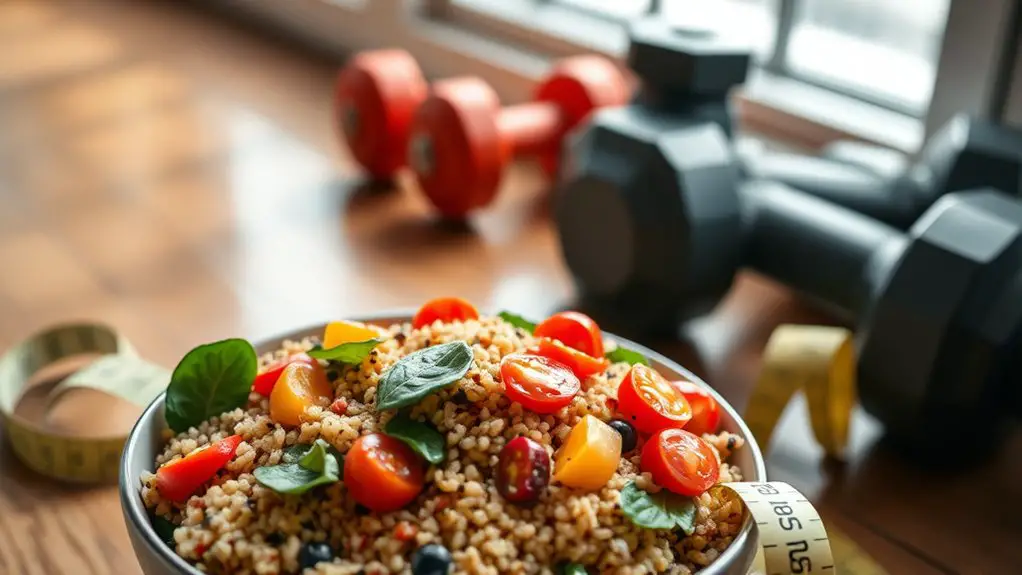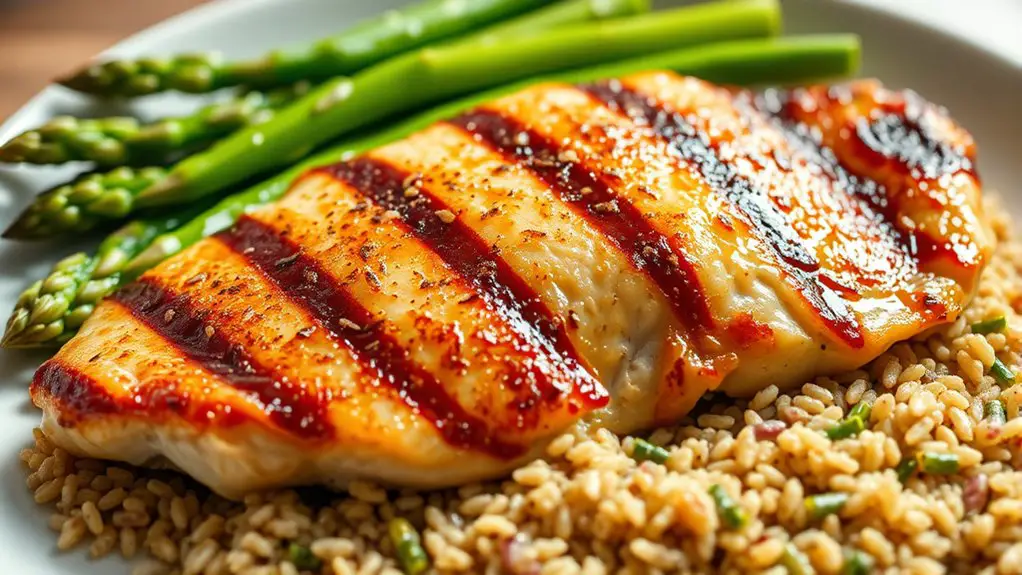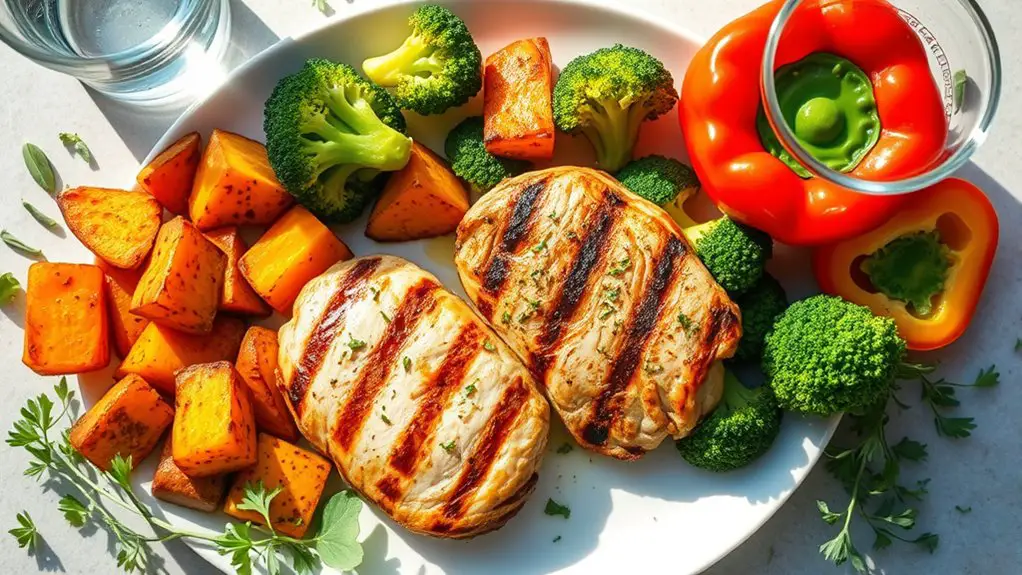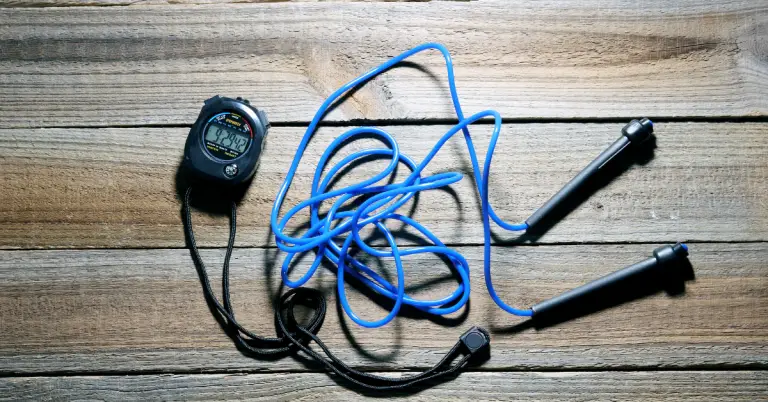How to Lose Weight Without Losing Muscle

To lose weight without losing muscle, focus on a balanced diet rich in protein and nutrient-dense foods. Calculate your caloric needs to maintain a slight deficit. Incorporate resistance training 2-3 times a week to preserve muscle mass and stay active with moderate cardio workouts. Stay hydrated and aim for quality sleep to support recovery. This approach helps maintain your metabolism and muscle. Discover more effective strategies to enhance your journey!
Understand the Importance of Muscle Preservation

When you’re trying to lose weight, it’s important to remember that preserving muscle mass is just as significant as shedding fat. Muscle preservation plays a key role in maintaining your metabolic health. When you lose weight too quickly or without proper nutrition, you risk losing muscle along with fat. This can slow down your metabolism, making it harder to maintain weight loss in the long run.
To support muscle preservation, focus on a balanced diet rich in protein. Incorporating resistance training into your routine is also crucial. Not only does it help you retain muscle, but it also boosts your overall strength. Additionally, aim for gradual weight loss rather than drastic changes. This approach guarantees your body adjusts safely, minimizing muscle loss. Remember, the goal isn’t just to lose weight but to achieve a healthier body composition, which means keeping your muscles intact while shedding unwanted fat. Furthermore, incorporating effective cardio workouts like skipping rope can enhance your weight loss efforts while preserving muscle.
Calculate Your Caloric Needs
How can you effectively lose weight while preserving muscle? The key lies in calculating your caloric needs. Knowing your daily caloric intake helps guarantee you’re in a slight caloric deficit, avoiding a drastic caloric surplus that could lead to muscle loss. To maintain muscle, it’s vital to understand your metabolic rate and adjust your diet accordingly.
Here’s a simple table to help you visualize your caloric needs:
| Activity Level | Daily Caloric Needs | Example of Adjusted Caloric Intake |
|---|---|---|
| Sedentary | 1,600-2,000 | 1,500 (500 calorie deficit) |
| Moderately Active | 2,000-2,400 | 1,800 (200 calorie deficit) |
| Very Active | 2,400-3,000 | 2,200 (200 calorie deficit) |
Prioritize Protein Intake

To effectively lose weight while preserving muscle, prioritizing protein intake is essential. Incorporating adequate protein sources into your diet helps maintain muscle mass and promotes satiety. Aim for a balanced approach, focusing on meal timing as well. Here are some key points to reflect on:
- Choose lean protein sources: Opt for chicken, turkey, fish, legumes, and low-fat dairy.
- Spread protein intake throughout the day: Aim for 20-30 grams of protein per meal to support muscle retention.
- Include protein-rich snacks: Greek yogurt, nuts, or protein shakes can be great options between meals.
- Reflect on post-workout protein: Consuming protein within 30 minutes after exercise can enhance recovery.
- Stay hydrated: Drinking enough water supports overall metabolic processes, including protein synthesis. Additionally, incorporating regular physical activity like skipping can further aid in weight loss while preserving muscle mass.
Incorporate Resistance Training
Incorporating resistance training into your routine can be a game-changer for preserving muscle while losing weight. You’ll discover various types of exercises and the benefits they offer, plus guidelines on how often and intensely to train. Let’s explore how to make resistance training work for you.
Benefits of Resistance Training
While many people focus solely on cardio for weight loss, resistance training offers an essential component for preserving muscle mass during your fitness journey. Incorporating resistance training not only helps you maintain muscle but also encourages muscle growth and strength gains. Here are some key benefits:
- Increased metabolism: Muscle tissue burns more calories at rest.
- Improved muscle tone: Resistance training helps you achieve a more defined physique.
- Enhanced strength: You’ll notice everyday activities become easier.
- Injury prevention: Strengthening muscles supports joints and reduces injury risk.
- Better overall health: It can improve bone density and enhance heart health.
Types of Resistance Exercises
Resistance exercises come in various forms, each offering unique benefits for building and preserving muscle mass. You can start with bodyweight exercises, like push-ups and squats, which are safe and effective. Resistance bands are another great option, providing adjustable tension for strength training without the risk of injury. Free weights, such as dumbbells and kettlebells, allow for compound exercises that engage multiple muscle groups simultaneously. Circuit training combines different exercises for a full-body workout, enhancing functional fitness. For those interested in powerlifting techniques, focus on heavy lifts to build strength. Don’t forget isolation movements, like bicep curls, to target specific muscles. Incorporating these types of resistance exercises into your routine can help you lose weight while maintaining muscle.
Frequency and Intensity Guidelines
To effectively lose weight without sacrificing muscle, it’s important to focus on how often and how intensely you engage in resistance training. Balancing exercise frequency and workout intensity is key to maximizing your results while minimizing the risk of injury. Here are some guidelines to keep in mind:
- Train at least 2-3 times a week for ideal muscle retention.
- Incorporate a mix of compound and isolation exercises for balanced development.
- Aim for 8-12 repetitions per set at a moderate to high intensity.
- Allow 48 hours of rest between sessions targeting the same muscle groups.
- Listen to your body; if you’re fatigued, adjust your workout intensity or frequency to guarantee safe progress.
Manage Your Cardio Workouts
Although cardio workouts are essential for burning calories and improving cardiovascular health, managing their intensity and duration is important to preserve muscle mass. To achieve this balance, consider incorporating interval training into your routine. By alternating high-intensity bursts with moderate activity, you can enhance fat loss while minimizing muscle breakdown.
Additionally, introducing cardio variety is significant. Mixing different forms of cardio—such as cycling, swimming, or brisk walking—can prevent overuse injuries and keep your workouts engaging. Aim for around 150 minutes of moderate aerobic activity per week, but listen to your body. Incorporating jump rope workouts can also provide an effective cardiovascular challenge while toning muscles.
If you notice fatigue or muscle soreness, it might be time to dial back your cardio or include more recovery days. Always prioritize form and safety over intensity, ensuring your body can recover and rebuild. By managing your cardio workouts wisely, you’ll support your weight loss goals without sacrificing muscle.
Focus on Nutrient-Dense Foods

When you prioritize nutrient-dense foods, you’re not just cutting calories; you’re fueling your body with the essential vitamins and minerals it needs to maintain muscle mass while losing weight. Choosing the right foods enhances nutrient timing, ensuring your body gets what it needs when it needs it. Incorporate superfood choices into your meals to supercharge your weight loss efforts.
Prioritizing nutrient-dense foods fuels your body, supports muscle maintenance, and optimizes weight loss efforts.
Here are some nutrient-dense options to reflect upon:
- Leafy greens (like spinach and kale)
- Berries (such as blueberries and strawberries)
- Quinoa or brown rice
- Lean proteins (like chicken breast and tofu)
- Nuts and seeds (including almonds and chia seeds)
Stay Hydrated and Get Enough Sleep
Staying hydrated and getting enough sleep are essential components of any weight loss journey, as both can considerably impact your body’s ability to maintain muscle mass. When it comes to hydration tips, aim for at least eight glasses of water a day, and consider drinking water before meals to help control hunger. You can also include hydrating foods, like fruits and vegetables, in your diet.
As for sleep strategies, prioritize getting seven to nine hours of quality sleep each night. Establish a calming bedtime routine, limit screen time before bed, and create a comfortable sleep environment. When you’re well-rested, your body can recover more effectively and support muscle retention. Remember, balancing hydration and sleep will not only enhance your weight loss efforts but also contribute to your overall well-being. Make these practices a priority, and you’ll set yourself up for success on your journey.
Frequently Asked Questions
Can I Lose Weight Without Exercising at All?
You can lose weight without exercising, but it requires careful dietary adjustments. By focusing on nutrient-dense foods and controlling portion sizes, you can create a calorie deficit. Keep in mind that your metabolic rate plays a significant role in weight loss, so consider how your eating habits affect it. While it’s possible to lose weight this way, combining diet with some physical activity is generally safer and more effective for overall health.
How Long Does It Take to Notice Muscle Loss?
Did you know that, on average, you can start noticing muscle loss after just two to three weeks of inactivity? When considering weight loss timelines, it’s essential to prioritize muscle preservation. If you’re cutting calories drastically or not exercising, you might see changes in your muscle mass sooner than you think. To stay safe, aim for gradual weight loss and include strength training to help maintain your muscle while shedding fat.
What Supplements Can Help Preserve Muscle While Losing Weight?
When you’re looking to preserve muscle while losing weight, certain supplements can be beneficial. Protein powder can help you meet your daily protein needs, supporting muscle maintenance during calorie deficits. Additionally, amino acids, especially branched-chain amino acids (BCAAs), can aid in preventing muscle breakdown. It’s crucial to choose high-quality, reputable products and consult with a healthcare professional to guarantee they fit your individual needs safely and effectively.
Is It Safe to Fast While Trying to Lose Weight?
Did you know that studies show intermittent fasting can boost your metabolic rate by up to 14%? If you’re considering fasting while trying to lose weight, it can be safe, but it’s essential to listen to your body. Make sure you’re consuming enough nutrients during eating windows to support your health. Gradually easing into fasting can help you assess how it affects your energy levels and overall well-being. Always consult a healthcare professional for personalized advice.
How Does Stress Affect Muscle Preservation During Weight Loss?
Stress can greatly impact muscle preservation during weight loss. When you’re stressed, your body releases stress hormones like cortisol, which can hinder muscle recovery and promote muscle breakdown. If you don’t manage stress effectively, it could lead to losing muscle mass while trying to shed pounds. Prioritizing relaxation techniques and proper nutrition can help mitigate these effects, ensuring your muscles stay healthy and recover well even during your weight loss journey.





